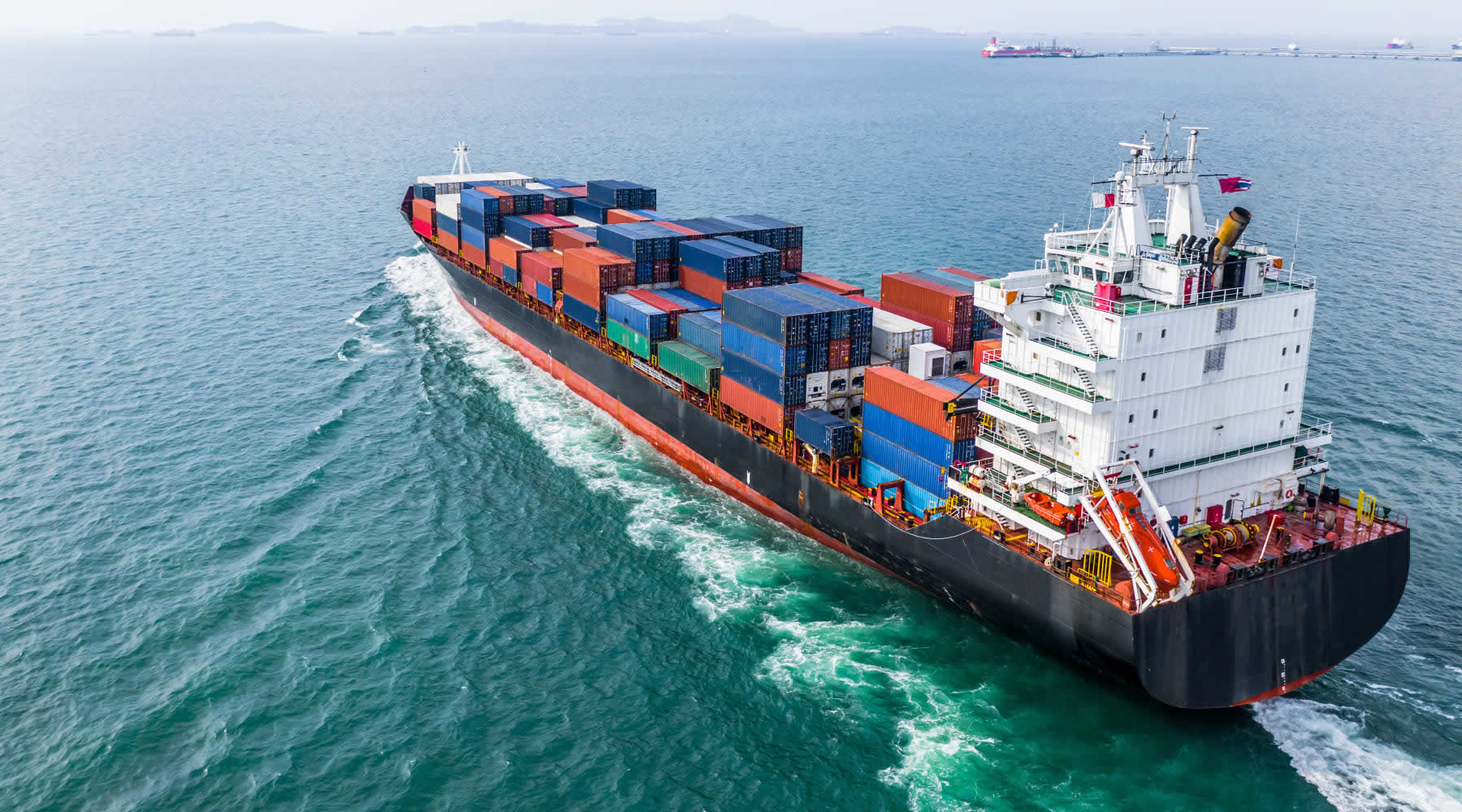Updated May 2022
The maritime shipping industry keeps the global economy humming, with 80 percent of world trade taking place by sea. This outsized reliance on shipping means the industry can also bring worldwide commerce to a halt, as evidenced by the recent grounding of a cargo ship, the Ever Given, in the Suez Canal that triggered a floating traffic jam of more than 400 ships.
With more than 90,000 ships making up the world’s commercial fleet, carbon emissions from shipping alone account for approximately 3 percent of the world’s CO2. Modernizing one of the world’s oldest forms of trade with cutting-edge, clean energy technology is no small task, but that is exactly what Bloom Energy has set out to do. It is important that marine trade vessels and cruise ships use energy that is not only clean, but also efficient. However, it is not simply a matter of swapping one engine out for another.
Internal combustion engines (ICEs) are the most common form of propulsion and power on large sea vessels. ICEs have traditionally run on heavy fuel oil, an extremely pollutant fuel. While heavy fuel oil is a plentiful resource, it is also one of the dirtiest fuels in the world. Published studies have recognized the impact that burning heavy fuel oil has on the climate, prompting both governments and maritime organizations to set emissions standards in an effort to curb the negative effects. The International Maritime Organization (IMO) has established guidelines for all cargo ship operators suggesting that by the year 2050, CO2 emissions from cargo ships should be half what they were in 2008. This has left the marine industry searching for ways to meet this goal.
The Solution is Here
The answer is fuel cells. Fuel cells are a highly efficient form of electricity production that will put us on a path to cleaner fuels, and will help ship owners, builders and partners reach IMO mandates. The standard LNG tanker can require anywhere from 10 to 40 megawatts of fuel cell power. A cruise ship can require up to 100 megawatts of power.
Bloom Energy’s fuel cells are fuel-flexible, meaning they can run on readily available natural gas, hydrogen, biogas or blends of any of those. And, Bloom Energy’s fuel cell technology has excelled at powering massive loads like stadiums, manufacturers and other large facilities on land. It makes sense that the same technology would be equally effective at sea.
By adopting land-based fuel cells for maritime applications, proposed designs of fuel cell-powered ships would have more than enough power to keep a working vessel, well… working. Natural gas fuel cells significantly reduce CO2 emissions and decrease smog-forming pollutants and particulate matter, like NOx and SOx, by more than 99 percent compared to entrenched power sources.
Maritime Certification
The certification process for marine fuel cells is a rigorous process, requiring that new technologies undergo a variety of operating scenarios to ensure they can withstand the rigors of the weather and use at sea. Classification societies like American Bureau of Shipping (ABS), Bureau Veritas (BV), Lloyd’s Register and DNV-GL expect any new maritime technologies to stand up to the rigors of maritime use. Bloom Energy’s fuel cells are expected to do just that.
Stringent certification standards require rigorous testing in an industry that already has centuries of rules and regulations. New technologies for ships should meet both current regulations and demonstrate alignment to future standards, which is what Bloom Energy is working on this year.
Full Steam Ahead
Bloom Energy is actively testing its technology for the marine environment, which differs greatly from fuel cells deployed on land. Ships and their onboard equipment must withstand and continue to operate effectively and safely with the constant motion of the ship and, at times, turbulent seas.
In Spring 2022, Bloom Energy’s fuel cell platform successfully completed ABS testing toward NTQ certification and Factory Acceptance Testing (FAT) with an outside testing agency. This means the fuel cells have been tested for functional safety, and the customer verified the performance of the fuel cells.
The next milestone is to install the systems on the ship and commission the system for sea voyage.
In addition to its own dedicated engineering and product teams, Bloom Energy has pulled in naval architects and marine engineering firm, Foreship, to collaborate on engineering and market aspects specific to the marine environment. Both teams have an eye for efficiency in their respective arenas, which is exactly what is needed to create solutions that meet the IMO’s mandate.
New technologies such as fuel cells often advance more rapidly than regulations. Given there is not an experience record of new technologies in maritime applications, concerns relative to safety, durability and effectiveness must be addressed. The New Technology Qualification (NTQ) process is designed to address those concerns by providing guidance and recommendations to assure a smooth, low risk adoption of the technology into maritime use. Passing the ABS testing represents a major step toward NTQ certification. Bloom Energy plans to continue with the ABS certification process, which ensures that the technology goes through a technical evaluation and study of production compliance.
In Bloom Energy’s path to an ABS classification and as part of the NTQ service its participating in, the company received NTQ verification as an alternative power source for vessels, which demonstrates efficient implementation of new technologies, a level of maturity, and that potential risks have been systematically reviewed.
In addition, as a continuation of Bloom Energy’s work to co-develop fuel cell-powered ships with Samsung Heavy Industries (SHI), an engineless, 100 percent fuel cell-powered liquefied natural gas (LNG) carrier has received Approval in Principle (AiP), or basic design approval from the maritime classification society, DNV. One hundred percent fuel cell-powered means that both auxiliary needs and ship propulsion would be powered solely by fuel cells.
We’re excited to continue this momentum with these significant steps forward to accelerate the marine industry toward a more sustainable future.
Rough Waters Call for Rougher Testing
During the rigorous ABS testing period, Bloom’s fuel cells withstood over 19 hours of sustained lateral and vertical vibrations. Vibration testing shakes the equipment at resonant frequencies more severe than the actual ship would experience, ensuring structural resiliency.
We also successfully completed tilt testing, to ensure our fuel cells will operate safely at sea, and several other key tests. Similarly, tilt testing imitates a range of motions that a ship may encounter navigating rough seas. Pitch, and roll motions on the tilt platform mimic specified angles and rates to demonstrate the technology’s readiness for use on water. Tests like these ensure that power generation is uninterrupted in rough sea situations when the crew needs dependable power most.
Bloom Energy’s fuel cells also successfully passed the Factory Acceptance Test with Bureau Veritas, a testing and compliance agency. The main objective of the Factory Acceptance Test is to validate the safety of the entire system’s functionality and performance. This represents the most comprehensive FAT test Bloom Energy has completed thus far, ensuring a safe, reliable performance onboard the cruise ship.
Following extensive testing and certification, Bloom Energy will complete the final testing phase, which is an on-water demonstration expected to begin in 2022.
Making Waves in a Centuries-Old Industry
And, that’s the easy part. Getting new technology aboard ships is not as simple as taking a vessel to a shipyard to be retrofitted. Maritime vessels are built around their power systems, meaning fuel cells must be included at the design phase. Ships being built now likely will not sail for several years.
As a result, marine fuel cells change the future of ship design. No longer encumbered by centralized engine rooms, the modularity, customization, and low-profile footprint benefits of Bloom Energy’s fuel cells give maritime vessels more flexibility in design, which can allow a more efficient hull design, expanded cargo space and enhanced resiliency.
Bloom Energy is making headway into helping shipping organizations meet emissions and efficiency regulations by moving power generation to cleaner alternative fuels, like natural gas and hydrogen. As regulations on maritime emissions become more environmentally focused, Bloom Energy’s fuel cell technology will enable vessels to meet these standards.
Bloom Energy’s innovative technology is breathing new life into a centuries-old industry and placing it squarely at the cutting edge.
#TogetherWeCan #BeTheSolution
 Timothy Schweikert serves as senior advisor, market development, marine solutions for Bloom Energy where he is focused on developing fuel cell-powered ships. Prior to Bloom, Tim spent over 30 years with General Electric, holding a variety of leadership positions spanning aviation, rail transportation, and marine. Most recently, as president and CEO of GE Marine Solutions, Tim led the development and implementation of innovative solutions across the GE industrial portfolio serving commercial, off-shore, and military marine segments. Tim’s other leadership positions at GE included president and CEO of GE Sub-Sahara Africa, president and CEO of GE Transportation China and Southeast Asia, general manager of GE Global Locomotive Operations, and he began his career with GE Aviation. He has a mechanical engineering degree from Marquette University, master’s in industrial engineering from the University of Cincinnati, and graduated from the GE Manufacturing Development Program. Tim lives in Cincinnati, Ohio with his wife and two daughters.
Timothy Schweikert serves as senior advisor, market development, marine solutions for Bloom Energy where he is focused on developing fuel cell-powered ships. Prior to Bloom, Tim spent over 30 years with General Electric, holding a variety of leadership positions spanning aviation, rail transportation, and marine. Most recently, as president and CEO of GE Marine Solutions, Tim led the development and implementation of innovative solutions across the GE industrial portfolio serving commercial, off-shore, and military marine segments. Tim’s other leadership positions at GE included president and CEO of GE Sub-Sahara Africa, president and CEO of GE Transportation China and Southeast Asia, general manager of GE Global Locomotive Operations, and he began his career with GE Aviation. He has a mechanical engineering degree from Marquette University, master’s in industrial engineering from the University of Cincinnati, and graduated from the GE Manufacturing Development Program. Tim lives in Cincinnati, Ohio with his wife and two daughters.



